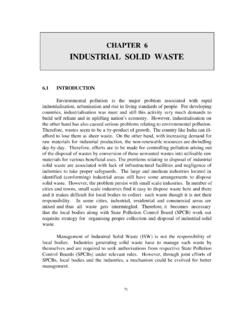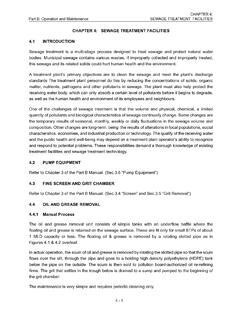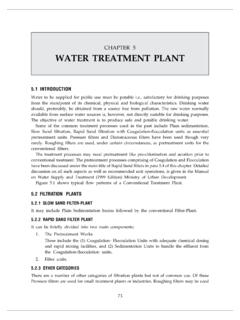Transcription of CHAPTER 7: RECYCLING AND REUSE OF SEWAGE
1 Part A: Engineering7 - 1 CHAPTER 7: RECYCLING AND REUSE OF SEWAGECHAPTER 7: RECYCLING AND REUSE OF SEWAGE No higher quality water should be used for a purpose that can tolerate a lower grade UN Council Resolution-1958 Many of the wars this century were about oil, but those of the next century will be over water. - Ismail Serageldin, Vice President, World Bank-1995 Question to finalistsTechnology is good for comfortable life; It is also blamed for environmental problems; How do you link Technology & Environmental Conservation? Answer by winning finalistAgrarian economy must REUSE water safelyFrom the Miss Earth contest, Manila, Sponsored by WHO 2001 Water should not be judged by its history, but by its quality.
2 Dr. Lucas van Vuuren, one of the pioneers of the Windhoek water reclamation system. INTRODUCTIONWith 80 countries and 40% of the world s population facing chronic water problems and with the demand for water doubling every two decades, these extracts mentioned above merit action. The largest source of REUSE resides in agriculture and the equally largest misplaced resource is SEWAGE in the habitations. In the Handbook on Service Level Benchmarking by MoUD, REUSE and RECYCLING of SEWAGE is defined as the percentage of SEWAGE recycled or reused after appropriate treatment in gardens and parks, irrigation, etc. and, is to be at least 20% to begin with. The objective of this CHAPTER is to bring out guiding principles for practice in India.
3 Overview of Current Practices in IndiaIn India treated SEWAGE is being used for a variety of applications such as (a) Farm Forestry, (b) Horticulture, (c) Toilet flushing, (d) Industrial use as in non-human contact cooling towers, (e) Fish culture and (f) Indirect and incidental uses. They are briefly mentioned hereunder. a) The CMWSSB has been promoting the growth of farm forestry in Chennai from the 1980s and this helps to promote a micro climate in a city environment. b) The Indian Agricultural Research Institute, Karnal has carried out research work on SEWAGE farming and has recommended an irrigation method for SEWAGE fed tree plantations. c) The University of Agricultural Sciences, Dharwad, Karnataka has found that SEWAGE could be used in producing vermicompost to be used for tree plantations provided its details with respect to composition of toxic substances are known.
4 D) Chandigarh is using treated SEWAGE for horticulture needs of its green areas. e) Delhi has put in place planned REUSE of treated SEWAGE for designated institutional centres. Part A: Engineering7 - 2 CHAPTER 7: RECYCLING AND REUSE OF SEWAGE f) The Government of Karnataka has issued an official directive to take all necessary steps to ensure that only tertiary treated SEWAGE is used for non-potable purposes, like all gardening including parks, resorts and golf course. The Bangalore Water Supply and Sewerage Board will make all arrangements including construction of filling points, installation of vending machines at STP for supply of tertiary treated SEWAGE in multiples of thousand litres and that non-compliance of the directions attracts penal provisions in accordance with section 15 and section 17 of the Environment (Protection) Act 1986.
5 G) In major metropolitan cities like Delhi, Mumbai, Bangalore and Chennai treated grey water is being used for toilet flushing in some of the major condominiums and high rise apartment complexes on a pilot scale. Care should be taken to ensure that Ultra filtration membranes are used in the treatment process to safeguard against chances of waterborne diseases. h) Secondary treated SEWAGE is purchased and treated for use in cooling water makeup in the industrial sector from as early as 1991 in major industries like Madras Refineries, Madras Fertilizers, GMR Vasavi Power plant in Chennai as also in Rashtriya Chemicals and Fertilizsers in Maharashtra and most recently in the Indira Gandhi International Airport in Delhi and Mumbai International Airport.
6 I) In Kolkata, the Mudiali fish farm occupying an area of 400 hectares is used for growing fish, which is then sold for human consumption. j) The UNDP conducted a detailed study in the 1970s and identified a sand basin on the coast of Bay of Bengal, where secondary treated SEWAGE of the Chennai city can be infiltrated through percolation ponds and extracted for specific industrial use in the nearby petro-chemical complex. However, this project has not been implemented. k) The Bengaluru city is facing a freshwater crisis and it has been considered to study a pilot model of the Singapore NEWater for indirect augmentation of water by advanced treatment of secondary facilities. At present, this project proposal is a statement of capability to formulate a technically feasible and financially viable project and of course the biggest challenge of going through and obtaining public acceptance is understandably a long drawn out process.
7 Overview of Current Practices in the WorldThe use of treated SEWAGE elsewhere in the world is listed herein and in Appendix a) Agriculture: It is used for irrigation in certain places in Africa, Israel, Mexico and Kuwait. b) Farm Forestry: Treated SEWAGE is used for watering urban forests, public gardens, trees, shrubs and grassed areas along roadways in certain places in Egypt, Abu Dhabi, Woodburn in Oregon USA. It is also used for timber plantation in Widebay Water Corporation in Queensland, Australia. It is used for alfalfa plantation in Albirch Palestine. c) Horticulture: Certain places in Elpaso in Texas, Durbin Creek in Western California in USA. d) Toilet flushing: Certain locations in Chiba Prefecture, Kobe City, and Fukuoka City and Tokyo Metropolitan in A: Engineering7 - 3 CHAPTER 7: RECYCLING AND REUSE OF SEWAGE e) Industrial and commercial: essentially used for cooling purposes in Sakaihama Treated Wastewater Supply Project, Japan, Bethlehem Steel mills, USA.
8 SEWAGE reclaimed as high quality water is supplied to Mondi Paper Mill and SAPREF Refinery in Durban, South Africa. Landscape and golf course irrigation in Hawai, f) Fish culture: It is used in fish hatcheries / fish ponds in Vietnam and in Bangladesh g) Groundwater recharge: Orlando and Orange County Florida, Orange County California, Phoenix (Arizona), Santa Rosa (California) Recharge Project all in USA. h) Indirect recharge of impoundments: Restoration of Meguro River in Japan, NEWater project in Singapore, Windhoek in Namibia, Berlin in Germany i) Other uses: Coach cleaning, subway washing and water for building construction is being practised in Jungnang, Nanji, Tancheon, Seonam in Seoul and treated SEWAGE sprinkled on the water retentive pavement that can store water inside paving material at Shiodome Land Readjustment District (Shio Site) in Tokyo and this reduces the surface CASE STUDIES IN RECYCLING AND REUSE OF Raw SEWAGE Treatment and REUSE as Cooling Water at M/S GMR Vasavi Power Plant, Chennai, The Pride of Place This plant is the first of its kind in Asia commissioned as early as 1999, where the raw SEWAGE of Chennai city is treated to recover (a) water of grade suitable for makeup in the cooling water and (b)
9 Is also further treated to recover a water of boiler grade. Treatment SchematicThis is shown in Figure Raw and Recovered SEWAGE QualitiesThese are given in Table and Table Step by Step Reasoning of the TreatmentNeed for Equalization Basin Up Front: The flow of SEWAGE is not uniform throughout 24 hours and the biological treatment plant can absorb the fluctuations and still yield a fairly steady level of treated SEWAGE quality. However, in the Lime addition of the chemical system, the flow rate should be necessarily uniform, to facilitate dosing of chemical uniformly. This implies flow equalization necessarily at some point. It was decided to have this before the biological treatment itself, so that the dosage of Sodium bicarbonate whenever needed (before the primary clarifier to ensure adequate bicarbonate alkalinity for biological nitrification in the aeration tank) can be controlled easily in a steady state, which will further avoid unduly high Sodium in the resulting SEWAGE .
10 An example of sizing the equalization tank volume is given in Appendix A: Engineering CHAPTER 7 : RECYCLING AND REUSE OF SEWAGE7 - 4 Figure Treatment schematic of the M/S GMR Vasavi power plant SEWAGE REUSE plantPart A: Engineering7 - 5 CHAPTER 7: RECYCLING AND REUSE OF SEWAGEIn 1997, the aerators used were mostly slow speed surface aerators, and it was not easy to adjust the air input unlike the diffused aeration, where the VFD controlled motor permitted variations of air flow and hence, the oxygen input into aeration system based on the peak, average and lean flow durations could not be pro-rata adjusted. Hence, it was necessary for upfront feeding to the RO plant, the ammonia and phosphorous have to be removed as these can cause corrosion of some metal surfaces and biofouling in the circulating water respectively.






